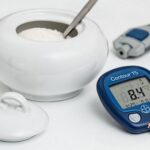diabetic
Diabetes is a collection of disorders that impact the body’s ability to use blood sugar (glucose).
Because glucose is a significant energy source for the cells that make up muscles and tissues,
it is vital to your health. It is also the brain’s primary source of energy.
The underlying cause of diabetes differs depending on the kind. However,
regardless of the type of diabetes, it might cause your blood sugar to rise.
Too much sugar in the bloodstream can cause significant health issues.
Type 1 diabetes and type 2 diabetes are both chronic diabetic diseases.
Prediabetes and gestational diabetes are two
diabetes disorders that can be treated. When blood sugar levels are higher than
usual but not high enough to be
categorized as diabetes, prediabetes.
Prediabetes is frequently a precursor to diabetes if no steps are taken to prevent it from progressing.
Gestational diabetes develops throughout pregnancy, although it can be reversed once the baby is born.
Symptoms of diabetes
- Extreme thirst
- Frequent urination
- extreme hunger
- unprecedented weight loss
The presence of ketones in the urine is a sign that something
is wrong (ketones are a byproduct of the breakdown of muscle
and fat that occurs when there is not enough insulin available)
- fatigue
- heightened arousal
- blurred eyesight
- sluggish healing sores
- frequent infections, such as skin or vaginal infections
Type 1 diabetes can strike at any age, but it is more common in childhood and adolescence.
The most prevalent type of diabetes, type 2, can strike at any age,
though it is more common in persons over 40.
Diabetes causes and risk factors
1. Diabetes’ fundamental causes and risk factors
The following are some of the primary causes of this dramatic growth in diabetes:
- Obesity is a problem.
- An insufficient amount of physical activity.
- Changes in the types of foods consumed. Ready-made foods are popular today.
They promote diabetes because they are high in fats and sugars quickly absorbed into the bloodstream, causing
insulin resistance.
2. type 1 diabetes causes and risk factors
Type 1 diabetes has an unknown aetiology. What is known is that your immune system assaults and destroy
insulin-producing cells in the pancreas, which are generally used to fight harmful bacteria and viruses.
This causes your body to produce no or very little insulin.
Instead of entering the cells, sugar accumulates in the bloodstream.
The cause of type 1 infection is thought to be a combination of genetic predispositions and
environmental variables, while many of these factors are unknown.
In type 1 diabetes, weight is unlikely to play a role.
Instead of battling and eradicating harmful germs or viruses, the immune system assaults and damages the insulin-
producing cells in the pancreas in type 1 diabetes.
As a result, the body produces little or no insulin, causing sugar to gather and aggregate
in the bloodstream instead of being transported to the body’s numerous cells.
The actual ocular cause of type 1 diabetes is not yet known, but the following are the most
prominent risk factors, which include the following:
- Family history: People who have a diabetic parent or sibling are more likely to develop type 1 diabetes.
- Viral illness exposure.
3. Type 2 diabetes causes and risk factors

Cells become resistant to the action of insulin in prediabetes — which can lead to type 2 diabetes
— and type 2 diabetes.
The pancreas is unable to generate enough insulin to overcome this resistance.
Sugar accumulates in the bloodstream instead of travelling to the cells that require energy.
Although genetic and environmental variables are considered to play a role in developing
type 2 diabetes
the specific cause is unknown. Although being overweight is significantly linked to
the development of type 2 diabetes, not all people with the disease are overweight.
Cells resist the action of insulin in prediabetes, which can proceed to type 2 diabetes if the
The pancreas fails to produce enough insulin to overcome this resistance.
Instead of being transported to cells and reaching them in various body parts,
sugar accumulates in the blood circulation in these circumstances.
Although the exact origin of these cases is unknown, extra fat, particularly in the abdomen,
and a lack of physical activity is a significant contributor.
Researchers are still looking for an accurate and correct answer to why only some people
get prediabetes and type 2 diabetes.
The subject of why only certain people develop prediabetes and type 2 diabetes is still being researched by scientists.
- Age: More than or equal to 45 years old.
- Weight: Overweight is defined as a BMI of 25 or higher.
- Diabetes runs in the family: a first-degree relative has the disease.
- Diabetes runs in the family, with first-degree relatives suffering from the condition.
- Physical activity: lack of physical activity.
- High blood pressure is defined as 140/90 mm Hg or more excellent reading.
- Hypercholesterolemia refers to a high level of harmful cholesterol.
- High blood triglyceride levels: Triglycerides are a form of fat found in the body.
- Where there is a personal history of vascular disorders.
- A personal history of mothers who gave birth to babies weighing more than 4.1 kg.
A variety of factors can cause diabetes during pregnancy.
The placenta generates hormones that aid and promote pregnancy during pregnancy, increasing insulin resistance.
The placenta enlarges and produces vast levels of these hormones throughout the second and third trimesters of
pregnancy, obstructing and complicating insulin’s activity.

In normal circumstances, the pancreas responds by producing more
insulin to overcome the resistance.
Still, the pancreas can’t always keep up, resulting in only a tiny amount
of glucose reaching the cells while
a considerable amount accumulates in the blood circulation.
This is the process by which gestational diabetes develops.
Gestational diabetes can affect any pregnant woman, although some women are more vulnerable than others,
and risk factors for diabetes during pregnancy include:
- Women over the age of 25.
- Personal or family history
- Overweight.
The placenta secretes hormones to keep your pregnancy going during pregnancy.
Insulin resistance is increased in your cells as a result of these chemicals.
To counteract this resistance, the pancreas secretes insulin typically.
However, your pancreas may be unable to keep up with changing circumstances.
As a result, less glucose enters your cells, and more stays in your blood, causing gestational diabetes.
3. Complications of gestational diabetes
The majority of women who have gestational diabetes have healthy kids.
High and untreated blood sugar levels, on the other hand, might cause difficulties for you and your kid.
The majority of pregnant mothers with gestational diabetes have healthy kids.
However, if a pregnant woman’s diabetes is imbalanced and not adequately monitored and controlled,
it can affect both the mother and the newborn. The following are the most significant complications:
-
Complications in your baby as a result of gestational diabetes include:
The following are the most noteworthy complications
- of overgrowth
- Hypoglycemia.
- Respiratory distress syndrome (ARDS) is a condition in which the body’s
- jaundice;
- Diabetes type 2 at an advanced age.
- the death.
As a result of gestational diabetes, the mother may experience complications such as:
- Eclampsia. High blood pressure, protein in the urine, and swelling in the legs and feet
are symptoms of this illness. Both the mother and the baby can suffer severe or even fatal complications
due to pre-eclampsia.
- Complications of gestational diabetes If you’ve had gestational diabetes before,
it’s very likely that you’ll get it again. You’re also more prone to get diabetes – type 2 diabetes —
as you become older.
Diabetes prevention is essential.
Type 1 diabetes is unavoidable. However, the same healthy lifestyle choices that aid in the treatment
of prediabetes, type 2 diabetes, and gestational diabetes can also aid in the prevention of these conditions:
- Consume nutritious foods. Choose foods that are high in fibre and low in fat and calories.
Fruits, vegetables, and whole grains should be prioritized. To avoid boredom,
make sure you have a range of activities.
- Increase your physical activity. Get at least 150 minutes of moderate-intensity aerobic activity every week,
or do 30 minutes of moderate-intensity aerobic activity most days.
- Get rid of the extra pounds. If you are overweight, decreasing 7% of your body weight,
or 14 pounds (6.4 kilograms) if you weigh 200 pounds, can lower your risk of diabetes (90.7 kilograms).
Do not, however, attempt to lose weight when pregnant. Consult your doctor about how much weight
you should gain during your pregnancy.
Focus on long-term improvements to your food and activity habits to maintain a healthy weight.
Remember the advantages of losing weight, such as a healthier heart, more incredible energy,
and improved self-confidence, to keep yourself motivated.
Medication may be used in some cases.
Metformin (Glumetza, Fortamet, and others) and other oral
diabetes treatments may reduce the incidence of type 2 diabetes.
However, good lifestyle choices are still important. To ensure you don’t develop type 2 diabetes,
have your blood sugar checked at least once a year.












